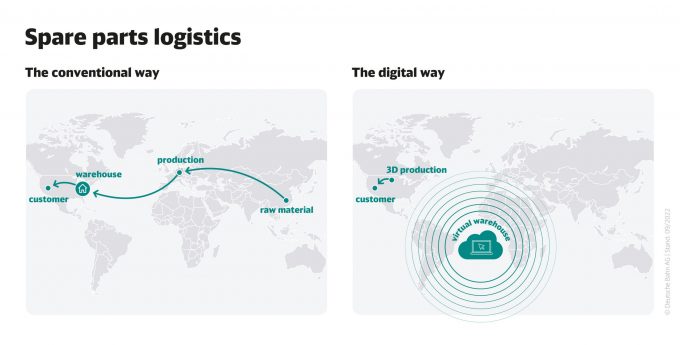DSV chief reticent on Schenker: the focus on growing market share
DSV focused on gains in market share, organic growth and making investors confident in its ...

Virtual warehousing and 3D printing has put DB Schenker firmly on the road to futuristic logistics, it said, launching its new system using its parent, Deutsche Bahn (DB), as its guinea pig.
DB said currently maintenance and repair stocks, worth up to $600m, involved thousands of spare parts for rail and locomotives having to be stored for when they are needed. However, with DB Schenker’s virtual system the company could cut some 10% from these storage costs, it said.
Some parts can be scanned, to create a digital version, and stored in the cloud. When there’s a need for a part, the digital scan is sent to the 3D printer to manufacture locally.
Arvid Eirich, who heads DB’s 3D manufacturing logistics supply chain, told The Loadstar: “We can save more than $60m a year in storage and inventory costs for parts we only need occasionally.”
DB Schenker CEO Jochen Thewes added: “This exemplifies what logistics of the future can do for customers. The aim is to avoid unnecessary warehousing and make supply chains even more stable and flexible.”
According to Mr Thewes, if you have a business that manufactures a product with a long lifecycle, of say, 25-30 years, you would need to service these products with spare parts, and he added: “These spares are not used that often and the capital having these parts in a warehouse for a long time is bound, so what do we do?
“We basically go with you and analyse your inventory and your demand patterns, and then say ‘these parts are viable for additive manufacturing’ and then we create a digital clone that is stored in our digital warehouse in the cloud; so you don’t have physical inventory.”
Mr Thewes said he believed the system would be good for customers and the climate, reducing delivery times, cutting long, climate-damaging journeys and saves on storage costs.
The system can also offer this cost-cutting opportunity to industries like automotive parts production and similar industries such as shipping and aviation, he added.
However, Mr Eirich said, 3D printing of parts can take some time, so the lead time for ordering, manufacture and delivery of parts must be factored in.
For DB, that means the company orders when it sees it is running low on particular parts, or when it is carrying out maintenance. Which means not all storage-associated costs are eliminated, but rather significantly diminished.
Comment on this article